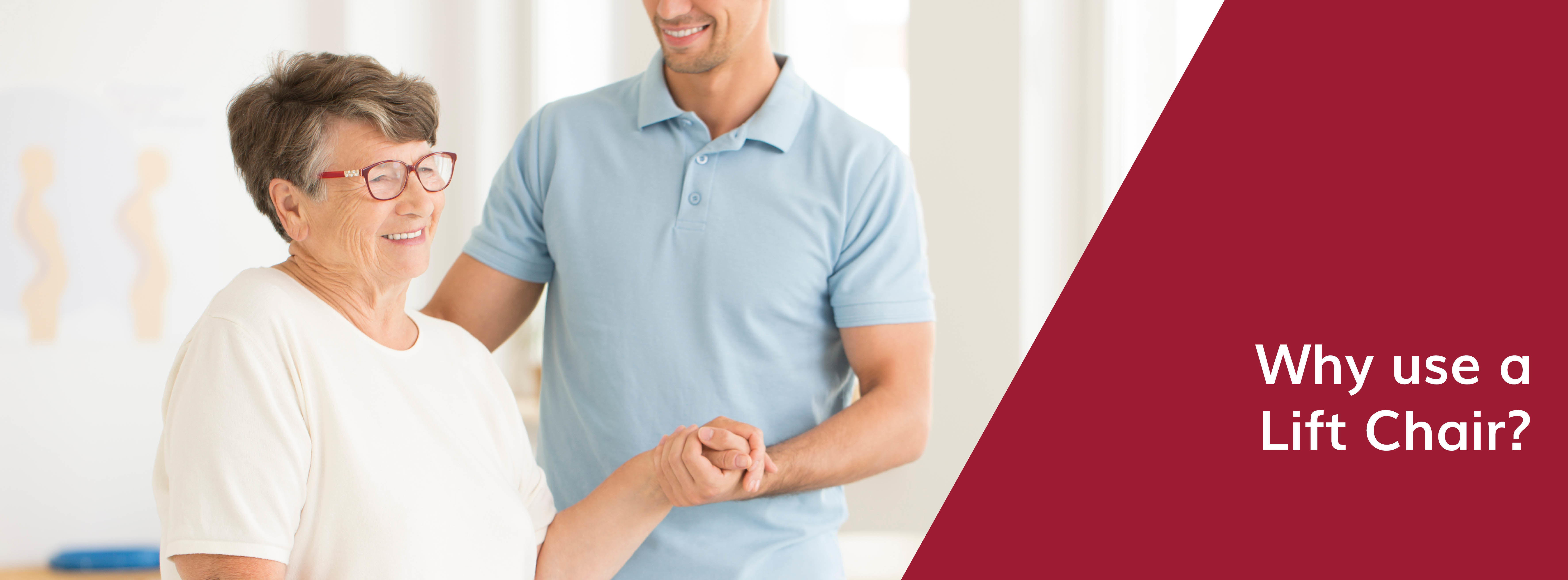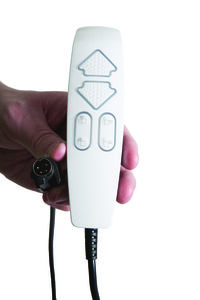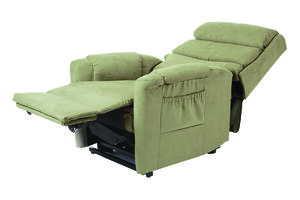At Access Rehabilitation Equipment, we commit to providing you and your loved ones solutions for life! Fitting your lifestyle, each aid and equipment is tailored to the unique challenges you are facing, so work with us to find the independence and mobility you want!

An electric lift chair may be similar in appearance to a regular reclining chair but it really is much more. Similar to a regular reclining chair, a lift chair can also be adjusted from upright to reclining and vice versa with a simple push of a button. Some of the many benefits experienced by electric lift chair users include relief from arthritis, back pain, as well pain relief for sore and stiff joints. In some cases it can even be a viable alternative to costly bathroom alterations for patients in need of massage and heat therapy.

What Is A Lift Chair?
A lift chair is a specially designed chair that has a built-in mechanical lifting system to allow its user to safely transition between sitting and standing positions. By simply pressing a button or using a remote control, the user can control the chair’s movement, which is easier and safer for individuals with mobility issues or difficulties getting up from a seated position.

Lift chairs offer a range of sizes, designs, and optional features. They are available in varying widths and heights, upholstery materials like fabric, vinyl, or leather, and customizable options such as the number of positions, heat, and massage functions. This allows you to personalize your lift chair to suit your specific needs.
Lift Chair Features
Once you’ve decided that a lift chair or recliner suits your needs, it’s essential to understand how to select one that offers the necessary support and functions. Here are some of the key features to consider in purchasing one.
-
Position Options

One of the most vital functions of a lift chair or recliner is its range of positions. While all lift chairs facilitate the basic sit-to-stand functions, certain chairs and recliners offer additional positioning options. There are three types of lift chairs:
- 2-Position Lift Chairs: Standard 2-position lift chairs enable you to sit upright or recline to relax. This feature is ideal for light usage in a living room or sitting area.
- 3-Position Lift Chairs: Beyond sitting upright and reclining, 3-position lift chairs allow you to recline further back but not entirely flat and can stop at any degree of recline in between. A 3-position lift chair is an ideal option for napping or for people who cannot sleep lying flat in a bed.
- Infinite Position Lift Chairs: Lift chairs with infinite positioning provide the utmost flexibility. These lift chairs, also known as full recline, can recline into a flat position where the backrest is parallel to the floor). Infinite position lift chairs feature adjustable head and footrests, allowing virtually endless options for your chair position. This type of lift chair can be helpful to relieve spinal pressure and muscle tension and improve circulation.
-
Size and Fit
When deciding on the ideal lift chair for you, the crucial factor often comes down to finding the right fit. Contrary to the belief that the bigger is better, this doesn’t hold true for lift chair recliners. Finding the right fit for your body is ideal for maintaining good posture and receiving adequate support. In terms of choosing the appropriate lift chair size, there are three measurements to consider:
- The seat height from the floor
- The seat depth
- The seat width
While each lift chair manufacturer may have slight variations in their sizing approach, typical size options include petite, small, medium, large, x-large, and xx-large. Some lift chair models may also come in wider and higher weight capacity options.
-
Weight Capacity
In addition to finding a lift chair that fits your body, you should verify the weight capacity before buying one. Finding a lift chair with an appropriate weight capacity will ensure the long-term safe operation of the chair’s mechanisms.
-
Material
When finding a lift chair, personal style plays a significant role. Fortunately, lift chairs are available in a variety of styles that can complement your home’s decor. The majority of models offer multiple color choices in both fabric and leather. Fabric provides a warmer and cozier feel, whereas leather offers a high-end look that’s easy to maintain.
-
Budget
While giving importance to quality remains essential, affordability is another aspect to consider. Look for lift chairs that strike a balance between quality and cost-efficiency. It’s advisable to compare prices, features, and customer reviews to secure a chair that meets your family’s requirements without exceeding your budget.
Extra Features
Some lift chairs offer a variety of features that aren’t medically essential but can enhance the overall chair experience. Additional lift chair features may include:
-
Heat & Massage: Lift chairs with heat and massage functionalities are gaining popularity. The mix of heat and therapeutic pressure can relieve back and joint discomfort, creating a spa-like relaxation experience with the confines of your home.
-
Lumbar Support: If you struggle with back issues or find it challenging to maintain proper posture in a regular armchair, a lift chair with added lumbar support might be the ideal solution. Some chairs offer power-controlled lumbar support, while others provide the option of removable support pillows.
-
Storage Pockets: In today’s market, many lift chairs are designed with external storage pockets on the chair’s base. These pockets offer a convenient place to store some small items inside.
-
Cup Holders: Cup holders are another common feature integrated into many modern lift chairs. Most chairs come equipped with one or two cup holders for your convenience.
-
Meal Trays: For many people, their lift chair is their primary seating spot throughout the day. Finding a model with a meal tray can eliminate unnecessary transfers during meal times.
-
USB Ports and Chargers: Some lift chairs even have built-in USB ports or wireless charging options to keep your devices powered up.
-
Battery Backup: Battery backup is an essential safety feature in case of power interruptions. It enables the lift chair to function when the power is down, ensuring that you can still use the lift chair to stand up or recline comfortably without being stranded in an uncomfortable position.
How Could A Lift Chair Help You?

One of the most significant features of an electric lift chair is its ability to actually raise the seated user up to a 45-degree angle to allow effortless standing and mobilisation. This feature alone is essential for the aged or frail person who can no longer stand up independently from a chair without creating a lot of strain and pressure on already tired arms, shoulders, and legs. The energy saved from this simple assistance can then be utilised for those other critical day to day tasks.
The rise & recline feature of a lift chair is especially convenient in assisting people in their day-to-day lives. A simple push of a button allows for easy maneuvers from a sitting position to a standing position. This eases patients into the most comfortable positions without having any need to utilise their hands, arms, or shoulders.
Most lift chairs have a lift capacity of up to 130kg. Other models designed for heavy duty purposes or bariatric clients may support up to 250 – 300kgs. In addition to these features, a correctly specified lift chair can provide an extremely comfortable and supportive surface to provide a greater seating tolerance.
There’s also the back rest recline & leg raise feature. This is usually used for circulation assistance as it allows the patient to maneuver into the most comfortable sitting position while also raising their legs.
So what sets these two functions apart? If we take a look at the many benefits, you can see why they work so well hand-in-hand:
- Greatly enhance comfort and functionality
- Provide shoulder support that alleviates fatigue and discomfort on the shoulders
- Ergonomic design that encourages proper and healthy sitting postures
- Helps in maintaining healthy muscle tone by relieving fatigue and degeneration in joints
- Helps in improving and promoting better circulation
What Is The Difference Between A Lift Chair And A Recliner?
The primary difference between a medical lift chair and a recliner is its intended purpose. Lift chairs are designed to assist with mobility and provide help with standing and sitting, while recliners are all about comfort and relaxation.
If you are looking for power lift chairs, Access Rehab Equipment’s great selection of electric lift chairs offers comfortable reclining positions and lift functions, allowing you to repose and relax in different positions that can benefit your health and well-being.
Who Can Use An Electric Lift Chair?
Although lift chairs are suitable for a broad range of users, their primary purpose is to meet the needs of individuals with limited mobility and the seniors. With a lift chair’s advanced safety features, they offer extra security for those who have difficulty transitioning between sitting and standing positions. In addition, they also provide dignity by allowing users to maintain their independence and remain securely in their most comfortable place—at home.
How Do You Choose A Lift Chair That is Right For You?
A lift chair is designed to greatly improve a patient’s quality of life and so it only follows that it must fit seamlessly into their existing environment. It will depend on a person’s individual needs but here are some common questions when it comes to getting a lift chair:
- Will there be pets around you for most of your day?
- Will you be eating or drinking when seated in your lift chair?
- Will it be for lounging and relaxation or are you also looking to sleep in your chair?
- If it’s going to replace a current lift chair, will you want something completely different or something that has the same feel of the one it’s going to replace?
- Will you be able to afford it and is there sufficient space in your home for it?
- Will you be needing it for a short time or for the longer term?
You may well have a similar list of questions as well? Rest assured that you’re not alone.
Bear in mind that a single motor lift chair will typically have just two buttons—one for up and one for down. These two buttons will control the backrest recline and the leg rest. A dual motor lift chair, on the other hand, will have separate controls for the backrest recline and the leg rest. What this means is that the backrest can be positioned in any position regardless of the leg rest position.
How To Choose A Lift Chair For The Elderly?

Buying a lift chair is a big decision that can significantly improve your daily life and mobility – or that of an elderly family member. When searching for the perfect lift chair for an elderly loved one, here are some considerations to ensure their comfort, safety, and specific needs.
-
Comfort: If the lift chair is not providing comfort to the user, all other factors become less significant. The correct lift chair can reduce the time spent in bed and enhance the overall quality of life.
-
Adjustability features: A chair with multiple adjustable features ensures the user's changing needs over time. This feature includes the ability to adjust the seat width so that the lift chair can always be adjusted to suit the size of the user, whether they gain or lose weight, and maintain proper positioning at all times.
-
Wheels: Lift chairs equipped with wheels enable much easier movement within a home or care facility. They also make it simpler for family members or caregivers to transfer the user between rooms or outside, promoting social interaction with others.
-
Pressure Management: When an elderly spends extended periods sitting or lacks the ability to adjust their position for comfort, their chair should incorporate pressure management. Pressure management enhances comfort and reduces risk of developing painful pressure ulcers, which can lead to complications.
-
Head support: For seniors who have difficulty controlling their head movements, its required to add support through a structured head pillow or built-in head support within the chair. This additional support ensures comfort and maintains proper alignment of the head, neck, and spine. In cases of poor head control, this feature can also affect essential functions like breathing and swallowing, making head support a vital consideration.
-
Lateral support: Lateral support assists elderly loved ones to maintain a centered posture, which becomes challenging as muscles weaken and gravity attempts to pull our bodies forward while sitting. Lateral supports enhance comfort and contribute to vital functions like digestion, which are influenced by posture and positioning.
-
Footrests: About 19% of our body weight goes through our feet. In cases of reduced mobility or immobility, the elderly should have the means to support their feet, whether through a leg rest, footplate, or placing their feet on the ground. This support ensures stability and effectively manages pressure distribution across the body.
-
Bacteria: For infection control purposes, the lift chair should be easy to clean and have no areas where dirt and bacteria can become trapped. This concern becomes particularly crucial when an elderly is dealing with incontinence, weakened immune system, or open wounds. You should consider the lift chair’s frame, upholstery material, and all potential areas where dirt could accumulate to ensure they are easily accessible for cleaning.
How To Get The Correct Size Of A Lift chair?
You will need to consider three basic measurements when choosing the right-sized lift chair:
-
Chair’s Height from the Ground
Seat height to the floor is the distance from the top of the seat to the floor. If the chair is too high, it can be challenging to get in and out of, causing your feet to dangle. However, a lift chair with a seat too close to the ground can be uncomfortable.
To find the ideal height, measure from the base of your foot up the back of your leg to the inside of your knee while sitting with your knees forming a right angle. This measurement determines the appropriate seating height for your lift chair.
-
Seat Width
A lift chair that is too narrow can cause pressure and discomfort. On the other hand, a lift chair that is overly wide may provide inadequate support.
To determine the seat width, take a seat and measure across the widest part of your hips or bottom. Add two inches to this measurement to determine the seat width you should look for in a lift chair.
-
Seat Depth
The seat depth of a lift chair is another crucial aspect to consider. If the seat is too deep, it will not allow you to comfortably rest against the lift chair’s back. If it is too shallow, your legs will hang off the front edge of the seat.
While seated, measure from the base of your back straight forward to the back of your knee; this measurement determines the ideal seat depth of lift chair that is perfect for you.
Once you have these measurements ready, you are well prepared to find the perfectly sized lift chair for you. To ensure a proper fit, check the specific size chart provided for the model of chair you are considering buying.



 Providing solutions for life
Providing solutions for life







